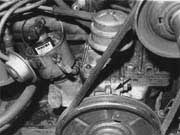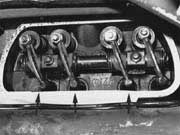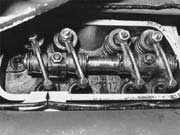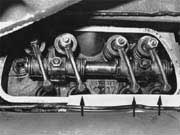Technical


In this photo of the driver's side of the car, the engine is at TDC for
cylinder three. The front three valves (on the left with the arrows under
them) are all loose and ready to be adjusted.

In the photo of the passenger's side of the car, the engine is still at
TDC for cylinder three. The rear valve (on the left, with the arrow under
it) is loose and ready to be adjusted.

Halfway done. Turn the crankshaft 360 degrees and you will again be at TDC
with the distributor rotor pointing the other way (toward the number one
plug wire). When the motor is at TDC for cylinder one, the right three
valves on the right side of the engine (see arrows) will be ready to
adjust.

At TDC for cylinder one, the single rightmost valve on the left side of
the engine (see the arrows) will be ready to adjust.
Valve Adjustment
Story by greg Raven
It is no
secret that if you want your Volkswagen's motor to last more than five or
ten thousand miles between overhauls, you have to change the oil and
adjust the valves. Changing the oil is easy, provided you have someplace
to dispose of the waste oil (Hint: Don't pour it down a drain or dump it
out on the ground. Find a garage or service station that recycles its oil
and leave it with them.
Adjusting
the valves is a little more work, but it is no less important. As your
motor runs, the heat and the force of the valve spring pulling the valve
closed can stretch the valve stem, making the valve longer. After enough
stretching, the small amount of clearance between the adjustment screw in
the rocker arm and the end of the valve will disappear. When this happens,
the adjustment screw will begin to hold the valve open a little instead of
letting it close fully, not allowing a good seal between the valve and the
valve seat, so you lose power. Even if that were the only result of having
tight valves, it would be bad enough. Unfortunately, there is another
reason why the valve face must seat firmly against the valve seat.
Inside the
combustion chamber, there is a lot of heat created by the burning
gasoline. Some of this heat soaks into the head of the valve. The valve
has only three ways to disperse this heat: cooling due to the intake
charge, heat dissipation through the valve stem and heat dissipation
through the valve seat.
Racers and
other high-performance enthusiasts can use what is called "charge
cooling"to help keep the valves alive, but unless you are an expert
at this sort of thing, you can pretty much write off charge cooling as the
answer to your hopes for a cool running engine.
That leaves
heat dissipation through the valve stem and seat. Valve stem heat
dissipation is pretty much a function of the valve stem diameter and the
condition of the valve guide. This is on the reasons why it is so
important to have good, right valve guides.
With the
scrawny, little valve stem you find on a Volkswagen valve, however, it is
clear that a lot of the cooling has to come from planting the valve face
on the valve seat long enough and firmly enough to allow heat to transfer
from the valve head to the cylinder head.
Now that
you understand all of that, it's time to start thinking about adjusting
your valves. You are going to need some valve cover gaskets, a 13mm
wrench, a screwdriver and a feeler gauge. Check your owner's manual (or a
Bentley manual) to find out what thickness feeler gauge you should be
using. If you have neither of these sources, get a 0.006-inch feeler gauge
to start out with stock engines (some experts recommend setting valves at
0.004 inch, but to start with 0.006 is fine--it gives you some margin of
error until you get good at this.)
It helps if
you are able to get your car up in the air a little with a set of
jackstands or a hoist. Open the engine cover and manually turn the motor
until it is at Top Dead Center (TDC). IT doesn't matter whether piston one
or piston three is on the compression stroke, just find TDC.
Now, slide
under the car and pull off the valve covers. If your hands aren't strong
enough to do the trick, wrap a shop rag around the valve cover bail, grab
the two ends of the rag and pull outward and downward sharply. The bail
should snap off. Depending upon how long the valve cover has been on (and
how hot the car has been), you might have to pry the valve cover away from
the head with a screwdriver. Place the valve covers on the ground so that
they catch any dripping oil.
It should
be pointed out that Volkswagen valves are adjusted with the engine cold.
You can't drive home from work, pop the covers and do a
"quickie"adjust, then speed off for the evening. The motor must
sit long enough so that it is cool to the touch. It might not be very
convenient, but at least you won't be burning your hands on this job.
As you look
up into the engine, you can see there are four valves on each side of the
engine...eight in all. Reach up and manually check for clearance of the
four closest to you. You should find that there are two
"patterns"to which valves have clearances and which valves
don't. Either the front three valves will have clearance (and the back
valve will be tight) or the back valve will have clearance (and the front
three will be tight). I say "should" because if you have a valve
that has lost all of its clearance, it won't be loose under any condition,
but that's the situation we're trying to prevent, right?
Insert your
feeler gauge between the end of the valve stem and the end of the valve
adjustment screw. If you have never done this before, give yourself some
time to get used to the way the feeler gauge feels. The gauge has to be
held "just right" in the gap. If you twist or pull on the feeler
gauge you will get an erroneous feel for what the gap is.
You are
looking for the feeler gauge to slip between the valve stem and the valve
adjustment screw with a little resistance. If the feeler gauge falls out
when you release it, the gap is too large. If you have to force the gauge
in and then strong-arm it out, the gap is too small.
Let's
assume that by this point you have determined that the gap isn't right.
Take the 13mm wrench and loosen the jam nut on the valve adjustment bolt
for the improperly gapped valve. Use the screwdriver to change the gap
while you monitor your progress with the feeler gauge. If you want to get
really trick, many retailers offer a combination wrench and screwdriver
just for adjusting your valves. Be careful that you don't clamp down on
the blade of the feeler gauge while you are tightening up the adjustment
because you will deform the gauge material and it will be more difficult
to get a good feel for the gap.
When the
gap feels right, hold the adjustment screw with the screwdriver and use
the 13mm wrench to tighten up the jam nut.
Murphy's
Law states that if the gap feels perfect, the adjustment screw will try to
turn when you tighten the jam nut. That's what the screwdriver is there
for. It might take a couple of tries, but don't panic. Make certain to
double check the clearance after you tighten down the jam nut.
Repeat this
procedure with the other three valves. You are now half done. Go up
topside again and rotate the engine 360 degrees until the TDC mark comes
up. Scrunch under the car again and check the clearance pattern. You will
see that it has reversed itself from side to side. The three that had no
clearance on one side now have clearance and the one valve with no
clearance on the other side now has clearance as well. You can now adjust
the remaining four valves as you adjusted the first four.
It all
sounds pretty rosy in print, but there are things that can come up. If the
rocker arm isn't bolted down tight, your adjustments will be off. There is
a far more common problem, however, and it can be pretty aggravating. You
insert the feeler gauge into the gap and notice that there is too much
clearance. You turn the adjustment screw a small fraction of a turn and
suddenly there is no clearance. And no matter how long you fool with it
there isn't any middle ground; the adjustment is either too loose or too
tight.
Here's
what's happening: The ends of the adjustment screws have developed little
flat spots from misadjustments, oil breakdown or just plain age. The cure
is to pick up a new set of adjusters. They normally come with jam nuts,
which is good because they can get pretty rounded off. Replace the old
adjusters with the new adjusters and life should once again be a bowl of
cherries for you.
Clean out
the valve covers and replace the old valve cover gaskets with the new
gaskets you bought. You do not need glue to keep the gaskets in place. Put
the covers back on and snap the bail wires in place. Let the car off of
the stands and check your oil lever.
By checking
your valve adjustment every 2,500 to 3,000 miles when you change your oil,
you will help ensure that you will never fall prey to a burnt valve.